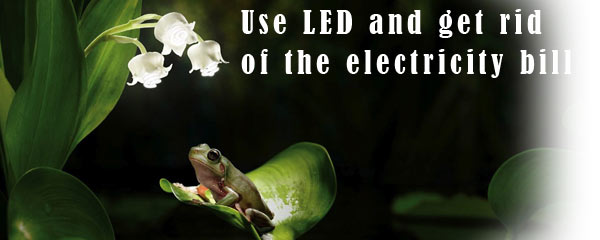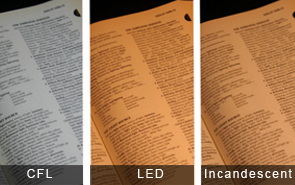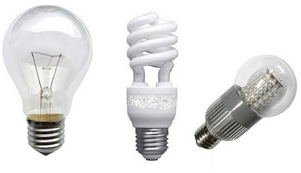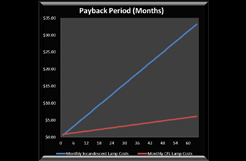 |
| |
 |
| Use LED lamps and reduce your electricity bill by Eng. T. N. Kankanamge |
| |
|
A LED lamp is a light-emitting diode (LED) product that is assembled into a lamp (or light bulb) for use in lighting fixtures.
Although electricity tariff has been modified recently; generation cost of electricity is still higher than the average selling price in Sri Lanka. Only way to reduce the electricity bill is by improving the efficiency and the effectiveness of electricity usage. Lighting is a most essential and significant electricity requirement for the day today life. Incandescent lamp, compact florescent lamp (CFL) and light emitting diode (LED) lamps are the available technologies for lighting. Incandescent lamps are very in-efficient. LED is the latest technology for lighting and LED bulbs are promoted as more energy-efficient and more durable than CFLs. Even though LED requires less wattage than CFL for the same amount of light, using CFL bulbs still is a good economic proposition considering the capital investment and the quality of the light.
|
| |
| LED market prices as at 01/09/2013 in Sri Lankan Rupees |
| Lumens (lm) |
LED (W) |
German (Branded) |
China (Branded) |
China (Assembled) |
| 2600 |
25 |
7,000.00 |
2,600.00 |
1,700.00 |
| 1600 |
16 |
5,000.00 |
2,250.00 |
1,450.00 |
| 1100 |
13 |
4,400.00 |
1,800.00 |
1,200.00 |
| 800 |
8 |
3,500.00 |
1,500.00 |
1,000.00 |
| 450 |
6 |
2,750.00 |
1,300.00 |
800.00 |
|
| |
|
LEDs play a major role in current lighting applications because of the low power required. It is a common misconception that LEDs are substantially efficient than CFLs. Most LED products available in the local market are in the same efficacy league as the CFLs, but display about 7% efficiency gain when compared with CFLs, almost in par with the good old linear fluorescent lamps – better known as the tube lights.
|
| |
| Lumens (lm) |
Incandescent (W) |
CFL (W) |
LED (W) |
| 2600 |
150 |
32 |
25 |
| 1600 |
100 |
23 |
16 |
| 1100 |
75 |
18 |
13 |
| 800 |
60 |
13 |
8 |
| 450 |
40 |
9 |
6 |
|
 |
| |
|
Normally incandescent lamps are cheaper than CFL and LED. But they are energy in-efficient and has a short life span. In energy usage terms, the cheapest bulb is LED. LED lamps intended to be interchangeable with incandescent lamps are made in standard light bulb shapes. LED lamps are made to replace screw-in incandescent or CFL bulbs. Most LED lamps replace incandescent bulbs rated from 5 to 60 watts. As of 2010, some LED lamps replace higher wattage bulbs; for example, one manufacturer claims a 16-watt LED bulb as bright as a 150W halogen lamp. A standard general-purpose incandescent bulb emits light at an efficacy of about 14 to 17 lumens/W depending on its size and voltage. According to the European Union standard, an energy-efficient bulb that claims to be the equivalent of a 60W tungsten bulb, must have a minimum light output of 806 lumens, irrespective of whether the power is lower than 13W or not This standard came due to different manufacturers claiming their LED bulbs are as bright as some value of incandescent lamp without mentioning the light output.
|
 |
| For 1600 Lumens Lamp |
Incandescent (W) |
CFL (W) |
LED (W) |
| Purchase price (Rs.) |
60.00 |
550.00 |
1,450.00 |
| Electricity usage (W) |
60 |
13 |
10 |
| Efficacy (Lumens/W) |
14.3
|
63.5 |
94.0 |
|
| |
|
Some models of LED bulbs work with dimmers as used for incandescent lamps. A very important aspect of LED lamps is the directional properties of the light beam emitted by certain types. This enables LEDs to be used in a variety of task lighting solutions, with the possibility of replacing a 20W CFL with a single 6W LED. These bulbs, whilst being more efficient than CFLs offer long life spans of 30,000 or more hours. However, these quoted life spans and any decline of performance of the lamps during the period, especially in hot and humid climates need further investigations and experience. It is an accepted fact that LED life spans are reduced if the lamps are operated at a higher temperature than specified. Incandescent bulbs have a typical life of 1,000 hours, compared to a quoted life of a CFL which is around 6,000 to 8,000 hours. The bulbs are required to maintain output light intensity throughout their life span. Energy Star specifications require the bulbs to produce a minimum of 90% of the original lumen output after 6,000 or more hours of operation, and in the worst case not more than 15%. LED lamps are available with a variety of color properties. The higher purchase cost than other types may be more than offset by savings in energy and maintenance. An analysis involving approximate values is given below (Assumption: 60 W equivalent bulbs which are lighting 4 hours per day in 90-120 block of domestic tariff) considering both initial investment and the energy cost. According to the graphs investment made on an LED replacing an incandescent lamp will recover within around 6 months.
|
| Description |
Incandescent (W) |
CFL (W) |
LED (W) |
| Duration (hr) |
1,200/- |
8,000/- |
30,000/- |
| Payback time with replacement of LED |
Around 6 months |
Around 2 years |
N/A |
|
 |
| |
|
Similarly, investment made on an LED replacing a CFL will recover in around 24 months, under the same assumption. However, the payback time might vary with the wattage and the working hours per day and the tariff block.
Considering both energy cost and life of the LED, it is worth to use LEDs for the locations where lighting is done for long hours per day. However, this analysis was done only from the consumer’s perspective. From the utility side, reducing the lighting load at system peak around 6.30 p.m. to 9.30 p.m. directly affects the generation costs. Generation cost is higher during the peak since expensive thermal power plants are dispatched to meet the demand. More electricity used during peak periods results in more generation costs to the utility. Finally that added cost is reflected in the electricity tariff and the overall economy indirectly. Hence using LED has both direct and indirect benefits to the consumer.
|
|
|